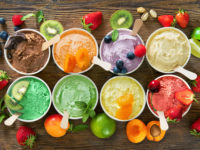When it comes to probiotics and prebiotics, you could say today’s consumers are very pro. In fact, according to a 2020 report from Hyderabad, India-based Mordor Intelligence titled “Probiotics Market — Growth, Trends, COVID-19 Impact and Forecasts (2021-2026),” the global probiotic market is expected to have a compound annual growth rate (CAGR) of 8.08% during the forecast period of 2020-2025.
“With the sudden impact of COVID-19, the market has witnessed a surge in demand for products that provide immune health, which is likely to impact the probiotics market positively,” the report notes.
And prebiotics are on a similar growth trajectory. According to Pune, India-based Quince Market Insights, the “global prebiotics market size was valued at $8.95 billion in 2020 and is projected to grow at a CAGR of 7%” between 2021 and 2030.
Natural partners
Probiotics and prebiotics have long been seen as natural partners to dairy; however, most customers currently seek out yogurt or yogurt drinks when looking for dairy products with added probiotics, says Karoline Kjaerulff, global business manager – fermented dairy for Heerlen, Netherlands-based DSM Food Specialties
“Traditionally, probiotics have been associated with dairy-based products, especially yogurts (spoonable and drinking) as they are created by the fermentation process,” explains Leanne Levy, director of sales and marketing, food and beverage for Deerland Probiotics & Enzymes, Kennesaw, Ga.
But there is room for these ingredients in other dairy categories, too, notes Sheri O’Brien, vice president, sales and marketing for Edmonton, Alberta-based BioNeutra North America Inc. For example, BioNeutra’s line of prebiotic dietary fibers can enhance “reduced-calorie ice creams, frozen treats and [ready-to-mix] protein drink mixes with appeals to digestive health,” she points out.
According to Joe O’Neill, vice president of sales and business development for A&B Ingredients Inc., Fairfield, N.J., dairy processors should consider adding probiotics and/or prebiotics to their products to attract today’s health-conscious consumers. Such shoppers are interested in these ingredients’ association with digestive health and immunity.
“In general, adding probiotics and supporting the use of probiotics with on-label claims and structure-function claims creates a healthy halo around such products,” he adds.
Even people who don’t currently purchase probiotics could be swayed to do so, notes June Lin, vice president, global marketing – Health & Wellness for ADM.
“Seventy-two percent of U.S. consumers not currently using probiotics state that they would be interested in buying probiotic products in the future,” she points out, citing research from Chicago-based ADM.
Prebiotic fiber is also a popular functional ingredient with today’s consumers, notes Lin.
“Nearly 80% of consumers believe fiber is important to their diet, and more than half associate it with benefits like healthy digestion,” she adds.
Pandemic speed-up
Holistic health trended before the emergence of COVID-19. However, the pandemic certainly amplified consumer interest in foods and beverages seen as conferring specific health benefits.
“There is an undeniable connection between the current coronavirus outbreak and consumers’ increased demand for products from the health and wellness sector,” O’Neill points out. “Since the onset of the COVID-19 pandemic, consumers have been seeking out products that have the potential to help them naturally support their immune system and resistance to viruses.”
Since the beginning of the pandemic, the number of people purchasing products with probiotics has grown, says Kjaerulff, “with six in 10 now using probiotics to some extent compared to five in 10 in 2018.” Consumers also are interested in products with immunity-boosting qualities.
“DSM research found that 36% of consumers associate probiotics with supporting immune health. In today’s climate, it’s no surprise that dairy products fortified with probiotics continue to be high in demand,” she adds.
Anke Sentko, vice president, regulatory affairs and nutrition communication for Mannheim, Germany-based Beneo, agrees that the pandemic increased consumer awareness of certain health issues.
“It’s no doubt that in this era of pandemic concerns, consumers have put a greater focus on gut health and weight and blood sugar management, as these factors have a direct impact on comorbidities associated with reactions to COVID infections,” she points out.
According to Lin, the pandemic led more people to take a “proactive” approach to their health.
“In fact, 44% of global consumers sought fortified and functional foods and beverages when surveyed in March 2021,” she notes. “Additionally, 61% of global consumers say that they are more conscious of the need to lead a healthy lifestyle because of COVID-19.”
And with holistic health top of mind, consumers are learning about how the gut microbiome affects wellbeing. ADM research revealed that “58% of global consumers are aware of the potential benefits that the gut microbiome can have on overall health,” Lin points out. And these consumers connect probiotics with having a positive effect on gut microflora.
“Supporting good digestive health is at the forefront of personal nutrition, considering the digestive system is the single biggest immune organ in our body,” O’Neill says. “Proper nutrition and probiotic supplementation have the ability to support the immune system, making it more resistant to illnesses.”
While probiotics are commonly associated with improving digestive health, Lin says research suggests these ingredients also have positive effects on “weight management, immune function, mood, skin appearance and more.”
ADM’s BPL1 strain (Bifidobacterium animalis subspecies lactis CECT 8145), for example, has been clinically shown to confer metabolic benefits, she points out.
Additionally, recent research has shown that probiotics can serve as “regulators of the immune system,” O’Neill says. This quality could be particularly helpful for those who have had COVID-19 — as it has been reported to cause long-term inflammation issues in some.
For its part, A&B Ingredients offers a plant-based probiotic, P. Acidilactici PA5051, that demonstrates “an ability to control interleukin levels in the bloodstream and play an important role in the modulation and control of the immune system and modulating the inflammatory response,” he says. “So no doubt there is potential and opportunities to explore further the role of probiotics in regulating immune function and help protect the body from an ‘overstimulated immune response.’”
Prebiotics improve health, too
Prebiotics also have been shown to improve “gastrointestinal issues” and may offer immunity benefits, notes Lin.
For example, Beneo’s plant-based inulin and oligofructose prebiotic ingredients are clinically proven to “support a healthy microbiota, improve the gut environment to make life for pathogens more difficult, strengthen the gut’s barrier function and more,” explains Sentko.
These ingredients confer such benefits by supporting the growth of naturally present good bacteria, she notes.
“They reach the large intestine intact (are not absorbed) — thus providing preferred feed for a few specific beneficial microorganisms,” Sentko adds.
ADM offers Fibersol — a line of prebiotic dietary fibers that it created in partnership with Matsutani LLC — that has a number of digestive benefits. These fibers “can promote the growth of beneficial microbes that aid in maintaining a healthy digestive system,” explains Lin. Fibersol ingredients also are classified as low-FODMAP ingredients, which means they are less irritating to those with certain digestive issues.
“Clinical studies also demonstrate that Fibersol ferments slowly in the large intestine, unlike inulin, which can be digested too quickly and may produce bloating or digestive discomfort,” Lin adds.
Prebiotics offer health benefits beyond improving digestive health, too. Beneo’s inulin and oligofructose, for example, also lower blood glucose responses, “by replacing sugar or other high-glycemic carbohydrates in formulations while enriching products with fiber,” Sentko notes.
Not all strains are equal
Probiotics and prebiotics confer a number of health benefits. However, manufacturers should remember that taste and texture are still paramount, as these ingredients can also cause formulation issues if not used correctly. Consumers have expectations of how a product should taste and feel and will not compromise on these standards in their search for value-added products, Sentko points out.
And not all strains of probiotics “are created equal,” O’Neill notes. Processors should be aware that some strains are more sensitive to heat, pH levels and oxygen than others — factors that can potentially kill the “live and active” bacteria before they ever reach the consumer.
“Those that do survive the manufacturing process and shelf life may be susceptible to the hyper-acidic environment of the stomach, where it may be destroyed before arriving in the small intestine,” explains Levy.
She suggests manufacturers turn to more resilient strains of probiotics such as Bacillus subtilis DE111 to avoid such problems.
“It has superb viability because B. subtilis species are spore-formers, meaning they form a protective shell that allows them to survive processing, storage and stomach pH to arrive intact and viable at their destination in the GI tract,” Levy explains
O’Neill says A&B Ingredients’ PA5051 probiotic offers advantages such as shelf-life stability and resistance to oxygen and antibiotics. The ingredient is “less sensitive to oxygen exposure and more resistant to heat” than other probiotics commonly used in dairy products such as Lactobacillus and Bifidobacterium.
“It has also been shown to decrease inflammatory biomarkers in the body that promote the modulation and control of the immune response,” he continues. Additionally, PA5051 is more resistant to harsh acidic atmospheres — meaning it “can naturally survive the stomach’s harsh environment.”
For its part, ADM offers a heat-treated version of its BPL1 probiotic “that can withstand harsh processing conditions like pasteurization, which is groundbreaking for fortifying different products and is also supported by research into factors associated with metabolism,” Lin says.
Prebiotics’ formulation benefits
Processors may choose to include prebiotics in their products for more than just their reported health benefits: These ingredients also offer many formulation advantages. For example, certain prebiotics can add mouthfeel in dairy products made with alternative sweeteners.
This includes BioNeutra’s VitaFiber IMO, which can “replace sugar’s bulk and functionality,” explains O’Brien. The prebiotic can stand alone as a sugar replacement in yogurt and ice cream applications, or it may be blended with high-intensity sweeteners.
“An advantage of sweetening with VitaFiber IMO or VitaFiber PLUS is that they contribute prebiotics to formulations,” she adds. “Additionally, VitaFiber PLUS is a source of dietary fiber. Both replace sugar’s functionality and are lightly sweet, like mild honey, making them ideal for replacing sugar in ice creams, frozen treats, and drink mixes, while contributing prebiotics.”
ADM’s Fibersol also provides formulation benefits in frozen desserts.
“Fibersol is a great addition to frozen treats because it improves nutritional value but does not impact their signature creamy texture,” says Lin. “Fibersol is neutral in flavor and color; has low viscosity; is water soluble with excellent clarity; and is heat-, acid-, shear-, freeze- and thaw-stable. It can also help to retain the right flavor and mouthfeel of reduced-sugar frozen desserts, ultimately providing a permissible indulgence.”
Sentko notes that Beneo’s inulin and oligofructose ingredients “are easily incorporated into an extensive range of dairy applications, as well as other food and beverage products,” as they increase fiber content without sacrificing taste or texture.
These all-star ingredients have other advantages, too, Sentko notes. Oligofructose also can mask off-notes when used in conjunction with high-intensity sweeteners, and inulin can serve as a fat-replacement as it “contributes to body and creamy mouthfeel.”
.jpg?t=1639062115&width=1080)





